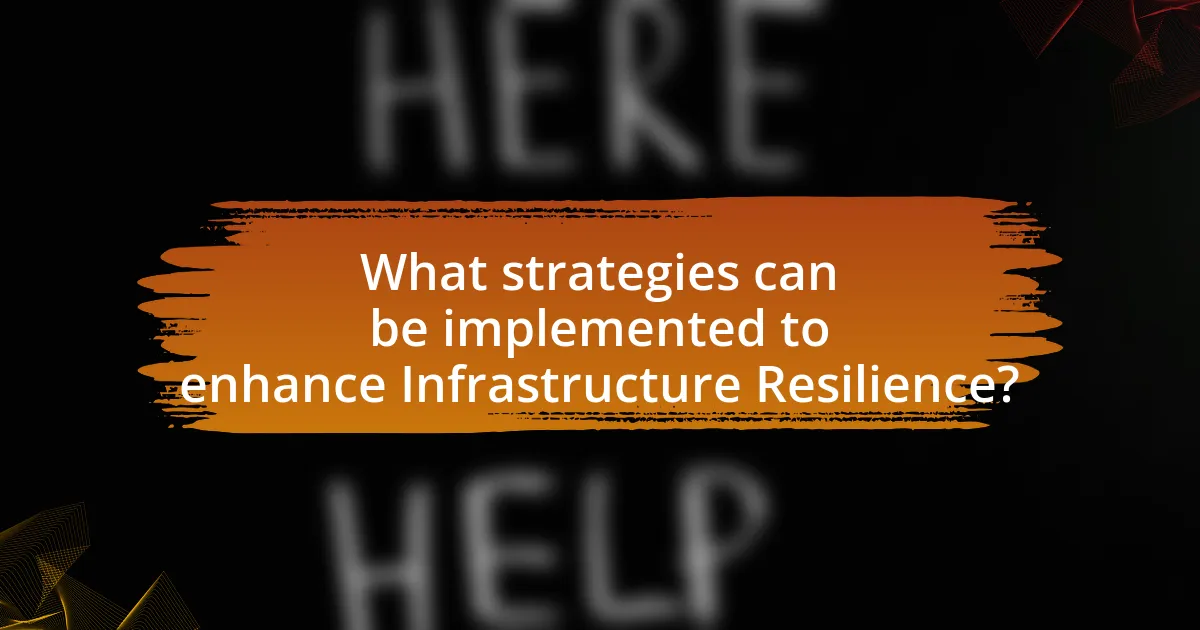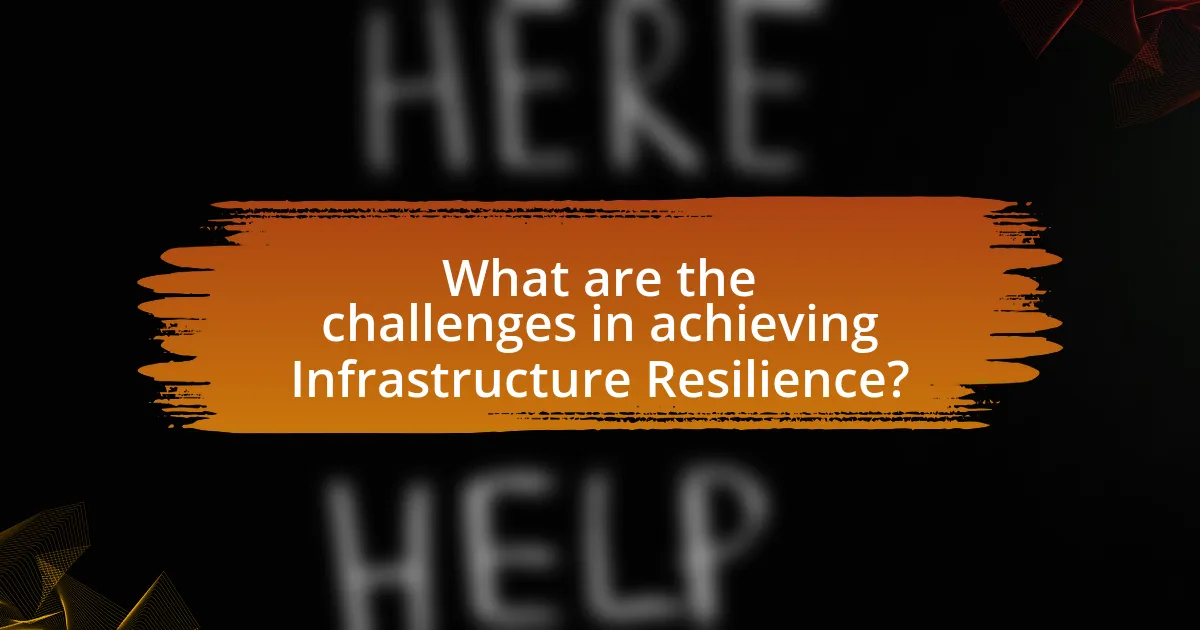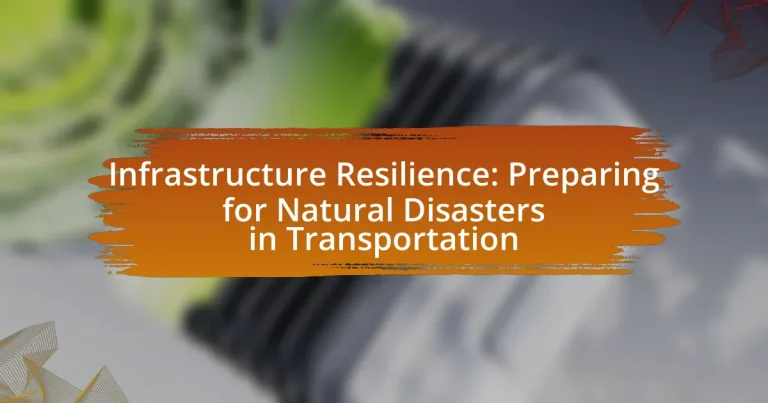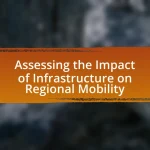Infrastructure resilience in transportation is defined as the capacity of transportation systems to anticipate, prepare for, respond to, and recover from disruptive events, particularly natural disasters. This article explores the relationship between infrastructure resilience and natural disasters, highlighting key components such as redundancy, flexibility, robustness, and rapid recovery. It discusses the importance of resilient transportation networks for public safety and economic stability, the potential impacts of natural disasters on infrastructure, and strategies for enhancing resilience through technology, risk assessments, and innovative materials. Additionally, it addresses the challenges faced in achieving infrastructure resilience, including funding constraints and regulatory influences, while emphasizing best practices and lessons learned from past disasters.

What is Infrastructure Resilience in Transportation?
Infrastructure resilience in transportation refers to the ability of transportation systems to anticipate, prepare for, respond to, and recover from disruptive events, particularly natural disasters. This resilience is crucial as it ensures the continuity of transportation services, minimizes economic losses, and enhances public safety during and after such events. For instance, studies have shown that resilient transportation infrastructure can reduce recovery times by up to 50% following major disruptions, highlighting its importance in maintaining operational effectiveness and community connectivity.
How does Infrastructure Resilience relate to natural disasters?
Infrastructure resilience directly relates to natural disasters by ensuring that transportation systems can withstand, adapt to, and recover from extreme weather events and other catastrophic occurrences. Resilient infrastructure minimizes damage and disruption during disasters, thereby maintaining essential services and facilitating quicker recovery. For example, studies have shown that cities with resilient transportation infrastructure, such as elevated roads and flood-resistant bridges, experience significantly less economic loss and faster restoration of services after events like hurricanes or floods. This correlation highlights the importance of investing in resilient infrastructure to mitigate the impacts of natural disasters effectively.
What are the key components of Infrastructure Resilience in transportation systems?
The key components of Infrastructure Resilience in transportation systems include redundancy, flexibility, robustness, and rapid recovery. Redundancy ensures alternative routes and systems are available during disruptions, enhancing reliability. Flexibility allows transportation systems to adapt to changing conditions and demands, which is crucial during emergencies. Robustness refers to the strength and durability of infrastructure, enabling it to withstand extreme weather events and other stressors. Rapid recovery focuses on the ability to restore services quickly after a disruption, minimizing economic and social impacts. These components collectively contribute to a transportation system’s ability to function effectively in the face of natural disasters.
How do these components interact during a natural disaster?
During a natural disaster, components such as transportation infrastructure, emergency response systems, and community resilience interact dynamically to mitigate impacts. Transportation infrastructure, including roads and bridges, must withstand extreme conditions to ensure emergency services can reach affected areas. Emergency response systems rely on this infrastructure for timely deployment of resources, while community resilience is enhanced through effective communication and preparedness measures that inform residents of evacuation routes and safety protocols. For instance, during Hurricane Katrina in 2005, the failure of levees and transportation systems significantly hampered rescue efforts, highlighting the critical interdependence of these components in disaster scenarios.
Why is Infrastructure Resilience important for transportation networks?
Infrastructure resilience is crucial for transportation networks because it ensures their ability to withstand and recover from natural disasters. Resilient transportation systems minimize disruptions, maintain connectivity, and facilitate emergency response during events such as hurricanes, floods, or earthquakes. For instance, the Federal Highway Administration reported that resilient infrastructure can reduce recovery costs by up to 50% and significantly decrease the time needed to restore services. This capability is essential for economic stability and public safety, as transportation networks are vital for the movement of goods and people, especially in crisis situations.
What are the potential impacts of natural disasters on transportation infrastructure?
Natural disasters can severely damage transportation infrastructure, leading to disruptions in mobility and economic activities. For instance, hurricanes can cause flooding that washes out roads and bridges, while earthquakes can lead to structural failures in highways and railways. According to the Federal Emergency Management Agency (FEMA), the 2017 Hurricane Harvey resulted in over $125 billion in damages, with significant impacts on transportation systems in Texas. Additionally, the American Society of Civil Engineers (ASCE) reported that inadequate infrastructure resilience can lead to increased repair costs and prolonged recovery times, emphasizing the need for improved planning and investment in resilient transportation systems.
How does Infrastructure Resilience contribute to public safety and economic stability?
Infrastructure resilience directly enhances public safety and economic stability by ensuring that critical systems can withstand and quickly recover from natural disasters. Resilient infrastructure minimizes the risk of catastrophic failures during events such as floods, earthquakes, or hurricanes, thereby protecting lives and reducing injuries. For instance, the Federal Emergency Management Agency (FEMA) reports that every dollar invested in disaster mitigation can save society an average of six dollars in recovery costs. Furthermore, resilient transportation systems facilitate the swift movement of emergency services and goods, which is essential for maintaining economic activities during crises. This capability not only supports immediate recovery efforts but also fosters long-term economic stability by reducing downtime and associated losses.

What strategies can be implemented to enhance Infrastructure Resilience?
To enhance infrastructure resilience, strategies such as adopting advanced materials, implementing redundancy in systems, and utilizing real-time monitoring technologies can be employed. Advanced materials, like high-performance concrete and corrosion-resistant steel, improve durability against extreme weather conditions. Redundancy in transportation systems, such as alternative routes and backup power supplies, ensures functionality during disruptions. Real-time monitoring technologies, including sensors and data analytics, allow for proactive maintenance and rapid response to emerging threats. These strategies collectively contribute to a robust infrastructure capable of withstanding natural disasters, as evidenced by case studies showing reduced damage and quicker recovery times in resilient systems.
How can risk assessments improve Infrastructure Resilience in transportation?
Risk assessments can significantly improve infrastructure resilience in transportation by identifying vulnerabilities and prioritizing mitigation strategies. By systematically evaluating potential hazards, such as natural disasters, transportation agencies can develop targeted plans to strengthen infrastructure, allocate resources effectively, and enhance emergency response capabilities. For instance, the Federal Highway Administration’s guidelines emphasize the importance of risk assessments in creating resilient transportation systems, demonstrating that proactive measures can reduce the impact of disasters on critical infrastructure.
What methodologies are used for conducting risk assessments?
Risk assessments are conducted using methodologies such as qualitative analysis, quantitative analysis, and hybrid approaches. Qualitative analysis involves expert judgment and stakeholder input to identify and prioritize risks based on their potential impact and likelihood. Quantitative analysis employs statistical methods and models to quantify risks, often using historical data to predict future occurrences and impacts. Hybrid approaches combine elements of both qualitative and quantitative methods to provide a comprehensive assessment. These methodologies are essential for understanding vulnerabilities in transportation infrastructure, particularly in the context of natural disasters, as they enable decision-makers to allocate resources effectively and enhance resilience.
How do risk assessments inform infrastructure design and maintenance?
Risk assessments inform infrastructure design and maintenance by identifying potential hazards and vulnerabilities, allowing for targeted improvements and resource allocation. These assessments evaluate factors such as environmental conditions, historical data on natural disasters, and structural integrity, which guide engineers in creating resilient designs that can withstand adverse events. For instance, the Federal Highway Administration emphasizes the importance of risk assessments in prioritizing investments for infrastructure upgrades, ensuring that critical transportation systems remain operational during and after disasters. By integrating risk assessment findings into planning processes, infrastructure can be designed and maintained to minimize damage and enhance recovery efforts, ultimately leading to safer and more reliable transportation networks.
What role does technology play in enhancing Infrastructure Resilience?
Technology plays a crucial role in enhancing infrastructure resilience by enabling real-time monitoring, predictive analytics, and rapid response capabilities. Advanced sensors and IoT devices collect data on structural health, environmental conditions, and traffic patterns, allowing for timely interventions before potential failures occur. For instance, the use of Geographic Information Systems (GIS) helps in assessing vulnerabilities and planning for disaster scenarios, which is essential for transportation systems prone to natural disasters. Furthermore, technologies such as machine learning algorithms analyze historical data to predict future risks, thereby informing infrastructure design and maintenance strategies. These technological advancements contribute to a more robust and adaptive infrastructure, ultimately reducing the impact of natural disasters on transportation systems.
How can data analytics and modeling predict vulnerabilities in transportation systems?
Data analytics and modeling can predict vulnerabilities in transportation systems by analyzing historical data, real-time sensor inputs, and simulation models to identify patterns and potential failure points. For instance, predictive analytics can assess traffic patterns, weather conditions, and infrastructure conditions to forecast where and when vulnerabilities may arise, such as during extreme weather events. Studies have shown that integrating machine learning algorithms with geographic information systems (GIS) can enhance the accuracy of these predictions, allowing for proactive maintenance and resource allocation. For example, the Federal Highway Administration reported that data-driven decision-making can reduce infrastructure failure rates by up to 30%, demonstrating the effectiveness of these analytical approaches in enhancing transportation system resilience.
What innovative technologies are being used to strengthen infrastructure against disasters?
Innovative technologies strengthening infrastructure against disasters include advanced materials, smart sensors, and predictive analytics. Advanced materials, such as fiber-reinforced polymers and self-healing concrete, enhance structural integrity and durability. Smart sensors monitor real-time conditions, detecting stress and potential failures, which allows for timely maintenance. Predictive analytics utilizes data modeling to forecast disaster impacts, enabling proactive infrastructure adjustments. For instance, the use of fiber-reinforced polymers has been shown to increase the lifespan of bridges by up to 50%, while smart sensor networks can reduce response times to structural issues by 30%.

What are the challenges in achieving Infrastructure Resilience?
Achieving infrastructure resilience faces several challenges, including funding limitations, outdated technology, and insufficient planning. Funding limitations hinder the ability to invest in necessary upgrades and maintenance, as seen in the American Society of Civil Engineers’ 2021 report, which estimated a $2.59 trillion investment gap in U.S. infrastructure. Outdated technology can impede the implementation of modern resilience strategies, as many systems still rely on legacy infrastructure that is not designed to withstand extreme weather events. Additionally, insufficient planning often results from a lack of collaboration among stakeholders, leading to fragmented approaches that fail to address the interconnected nature of transportation systems. These challenges collectively undermine efforts to enhance infrastructure resilience against natural disasters.
What financial constraints impact the development of resilient transportation infrastructure?
Financial constraints significantly impact the development of resilient transportation infrastructure by limiting available funding for necessary upgrades and maintenance. Budget shortfalls often lead to prioritization of immediate needs over long-term resilience investments, resulting in infrastructure that is ill-equipped to withstand natural disasters. For instance, the American Society of Civil Engineers reported in 2021 that the U.S. faces a $2.59 trillion funding gap for infrastructure improvements, which directly affects the ability to implement resilient designs and technologies. Additionally, reliance on federal and state funding can create delays and uncertainty, further hindering timely infrastructure enhancements.
How can funding be secured for resilience projects?
Funding for resilience projects can be secured through a combination of government grants, public-private partnerships, and community fundraising initiatives. Government grants, such as those provided by the Federal Emergency Management Agency (FEMA) or the Department of Transportation, specifically target infrastructure resilience and disaster preparedness, offering financial support for eligible projects. Public-private partnerships leverage resources and expertise from both sectors, facilitating investment in resilience initiatives while sharing risks and benefits. Additionally, community fundraising initiatives can mobilize local support and resources, enhancing project viability and sustainability. These funding avenues are critical for developing infrastructure that can withstand natural disasters, as evidenced by the increased allocation of federal funds for resilience projects following major disasters in recent years.
What are the long-term economic benefits of investing in Infrastructure Resilience?
Investing in infrastructure resilience yields significant long-term economic benefits, including reduced repair costs, enhanced productivity, and increased property values. By strengthening infrastructure against natural disasters, governments and organizations can minimize the financial impact of disruptions, which historically costs the U.S. economy approximately $300 billion annually due to weather-related damages. Furthermore, resilient infrastructure supports continuous operations, thereby maintaining productivity levels and reducing downtime for businesses. Studies indicate that every dollar spent on disaster resilience can save up to $6 in recovery costs, demonstrating a clear return on investment. Additionally, improved infrastructure attracts businesses and residents, leading to higher property values and increased tax revenues for local governments.
How do regulatory frameworks influence Infrastructure Resilience efforts?
Regulatory frameworks significantly influence infrastructure resilience efforts by establishing standards and guidelines that govern the design, construction, and maintenance of transportation systems. These frameworks ensure that infrastructure is built to withstand natural disasters, thereby reducing vulnerability and enhancing recovery capabilities. For example, the Federal Emergency Management Agency (FEMA) in the United States provides guidelines that require state and local governments to incorporate resilience measures into their infrastructure planning. This includes mandates for risk assessments and the integration of climate change projections into infrastructure projects, which have been shown to improve long-term resilience. Additionally, regulations often allocate funding for resilience initiatives, incentivizing investments in robust infrastructure that can better withstand extreme weather events.
What policies are essential for promoting resilient transportation systems?
Essential policies for promoting resilient transportation systems include investment in infrastructure upgrades, implementation of adaptive design standards, and establishment of emergency response protocols. Investment in infrastructure upgrades ensures that transportation networks can withstand extreme weather events, as evidenced by the Federal Highway Administration’s report indicating that resilient infrastructure reduces repair costs by up to 50% after disasters. Adaptive design standards, such as elevating roadways in flood-prone areas, are crucial; studies show that such measures can significantly decrease the risk of damage during natural disasters. Lastly, emergency response protocols, which include regular training and resource allocation, enhance the ability of transportation systems to recover quickly, as demonstrated by the successful recovery of transportation services in cities that have implemented comprehensive disaster preparedness plans.
How can collaboration between government and private sectors enhance resilience?
Collaboration between government and private sectors enhances resilience by leveraging resources, expertise, and innovation to improve infrastructure preparedness for natural disasters. For instance, public-private partnerships can facilitate the sharing of data and technology, enabling more effective risk assessments and response strategies. A study by the National Institute of Standards and Technology found that such collaborations can lead to a 30% reduction in recovery time after disasters, demonstrating the tangible benefits of coordinated efforts in enhancing infrastructure resilience.
What best practices can be adopted for improving Infrastructure Resilience?
To improve infrastructure resilience, best practices include conducting regular risk assessments, implementing redundancy in critical systems, and utilizing advanced materials and technologies. Regular risk assessments identify vulnerabilities and inform mitigation strategies, as evidenced by the Federal Emergency Management Agency’s guidelines, which emphasize the importance of understanding local hazards. Implementing redundancy ensures that if one component fails, others can take over, a principle successfully applied in transportation networks during Hurricane Sandy, where redundant routes minimized disruptions. Utilizing advanced materials, such as high-performance concrete and smart sensors, enhances durability and allows for real-time monitoring, as demonstrated in projects like the San Francisco-Oakland Bay Bridge retrofit, which improved its ability to withstand seismic events.
What lessons have been learned from past natural disasters in transportation?
Past natural disasters have highlighted the critical need for improved infrastructure resilience in transportation systems. One key lesson is the importance of designing transportation networks that can withstand extreme weather events, as evidenced by Hurricane Katrina in 2005, which exposed vulnerabilities in levees and roadways, leading to significant disruptions. Additionally, the 2011 earthquake and tsunami in Japan demonstrated the necessity for robust emergency response plans and real-time communication systems to ensure rapid recovery and minimize impact on transportation. Furthermore, the 2017 hurricanes in the Caribbean underscored the value of investing in adaptive infrastructure, such as elevated roadways and flood-resistant designs, to mitigate future risks. These events collectively emphasize the need for proactive planning, investment in resilient materials, and comprehensive risk assessments to enhance the reliability of transportation systems in the face of natural disasters.
How can communities engage in resilience planning for transportation infrastructure?
Communities can engage in resilience planning for transportation infrastructure by conducting vulnerability assessments to identify critical assets and potential risks from natural disasters. This process involves analyzing existing transportation systems, such as roads and bridges, to determine their susceptibility to hazards like flooding, earthquakes, or hurricanes. For example, the Federal Highway Administration emphasizes the importance of integrating climate change projections into planning efforts, which can help communities prioritize investments in infrastructure upgrades and maintenance. Additionally, communities can foster collaboration among stakeholders, including local governments, transportation agencies, and residents, to develop comprehensive resilience strategies that incorporate diverse perspectives and expertise. Engaging in public outreach and education initiatives can also enhance community awareness and support for resilience planning efforts, ultimately leading to more robust and adaptable transportation systems.


